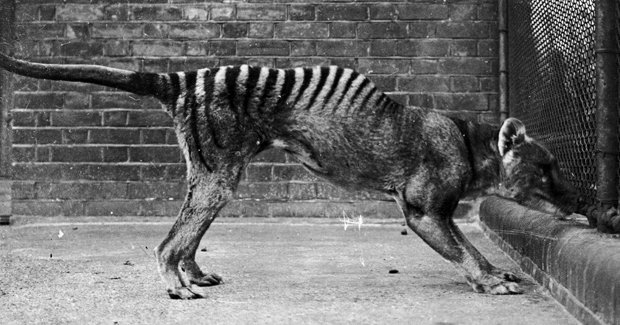Benjamin was probably not the last thylacine, says study

IN JULY 1936, thylacines were finally granted full protection from hunters. Two months later on 7 September 1936 the last known thylacine, a male named Benjamin, died at Hobart Zoo. That was 80 years ago today. No thylacine has been caught alive or dead since.
The long sad story of what was the world’s largest marsupial carnivore and it’s very public decline has haunted Australians. The thylacine has, scientists such as Tim Flannery have concluded, most likely vanished from Earth completely – pushed off the extinction cliff by hunters, disease, habitat loss or all three issues in concert, no-one is sure.
Today, optimists and dreamers still search for traces of the mysterious creature. And they are tantalisingly buoyed by the occasional report of a sighting (including one that made the news today of alleged video evidence of a thylacine in South Australia). A study of their distribution and sightings published in the scientific journal Australian Zoologist earlier in the year suggests that at least until the 1940s searches may not have been in vain, and tiny thylacine populations likely held on.

‘Benjamin’ the last-known Tasmanian tiger (pictured, above) died in 1936, but wild populations may have survived into the 1940s.
Thylacines probably existed into the 1940s, and perhaps beyond
The authors of the 2016 study say that based on the thylacine’s range and sightings before 1936, they calculate 200–400 thylacines survived into the 1930s. Almost certainly, they suggest, based on the same factors and evidence reported by a number of reliable experts, some thylacines survived into the 1940s. They do not claim any certainty beyond that point however.
Although there has been no conclusive evidence of another thylacine since Benjamin was captured in 1933, many, many eyewitness reports have surfaced since. However, the notoriety of the thylacine’s story, their mostly nocturnal and shy nature and the fallacy of eyewitness accounts has meant that a question mark surrounds the time that thylacines died out.
RELATED: On this day: death of the last Tasmanian tiger
The authors of the report note a number of credible sightings, the last one as late as 1982. This account came from Tasmanian Parks and Wildlife Officer Hans Naarding who claimed he saw a thylacine at Togari in Tasmania’s north-west, a fact that was kept confidential for two years while extensive field searchs were carried out within a 250km radius.
In his report Hans wrote:
“It was raining heavily. At 2am I awoke and out of habit, scanned the surrounds with a spotlight. As I swept the beam around, it came to rest on a large thylacine, standing side on some six to seven metres distant. My camera bag was out of immediate reach so I decided to examine the animal carefully before risking movement. It was an adult male in excellent condition with 12 black stripes on a sandy coat. Eye reflection was pale yellow. It moved only once, opening its jaw and showing its teeth. After several minutes of observation I attempted to reach for my camera bag but in doing so I disturbed the animal and it moved away into the undergrowth. Leaving the vehicle and moving to where the animal disappeared I noted a strong scent. Despite an intensive search no further trace of the animal could be found.”
The area where Hans claimed to have seen the 1982 specimen is in the north-west of Tasmania, and within a patch where remnant thylacine were likely to have lived say the authors.
It’s worth noting the recent reappearance of an almost mythical animal, the highly elusive night parrot has raised the hopes of thylacine hunters once again. The night parrot hadn’t been seen in 78 years until a dead one was found in 1999. A population was then confirmed in 2013, making national headlines. The Gilbert’s potoroo was also thought extinct for 20 years until it was rediscovered in 1994.
Did Australians hunt the thylacine to death?
Part of what haunts Australians about the thylacine is the fact that a series of private and government bounties were put on their heads from 1830 to 1914. At the time thylacines had earned a reputation as sheep killers, although historians say it’s more likely many sheep were taken by feral dogs. It’s estimated that at the time of colonial settlement in Tasmania in 1803, thylacine numbers were between 2000–4000, and that within a century hunters killed more than 2000 for bounties.
A particularly sharp drop numbers was noticed in 1905. Before this drop naturalists and scientists of that era had already been warning of a worrying decline in numbers and diversity, but the argument for killing thylacines by graziers had won out.
The steep decline in numbers in 1905 has raised questions about whether a mysterious illness was responsible for the thylacine’s disappearance. It is a matter of longstanding debate, with scientists at the University of Adelaide arguing that the loss of habitat and hunting alone could have led the species’ eradication.
Others have pointed to reports of a mange-like illness and a pneumonia. Some note that the disease arc of the Devil Facial Tumour Disease afflicting Tassie devils, relatives of the thylacine, mirrors 19th and 20th century reports of sick thylacine. (Last week it was reported that Tassie devils may be evolving to fight the facial tumour disease.)
There are few definitive answers to any of these debates. But, whether he was the last thylacine or not, the anniversary of Benjamin’s death is now national Threatened Species Day on which Aussies are asked to think about what we can do to help our threatened species survive.
READ MORE:
- Tassie tiger extinction: humans solely to blame
- Dingoes cleared of mainland extinctions
- Tasmanian devils are evolving rapidly to fight their deadly cancer
- Night parrot confirmed alive again after 30 years




